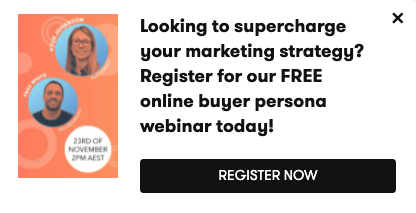If you’ve ever spent time in the presence of professional marketers (a lovely bunch, we must say), you’ve probably heard the terms ‘inbound marketing’ and ‘content marketing’ being thrown around. While this may sound a bit like a foreign language to the uninitiated, both are vital marketing strategies that help businesses thrive.
If you’re having flashbacks to high school French class right now, there’s no need to fret! While marketing terms can sometimes seem a little jargony, these strategies aren’t rocket science and could help give your brand a little extra je ne sais quoi!
What is content marketing?
Yep, you guessed it – content marketing is all about creating content designed to generate interest in your business and drive sales. If this evokes images of zombie-like writers churning out endless blog posts, you can think again. In today’s complex digital world, content creation is all about experimenting with new media and testing out search engine optimisation (SEO) strategies to help push your website to the top of Google’s search pages.
The world of content marketing is super diverse, allowing you to try out tons of new ideas to attract potential customers. Some of the most common forms of content marketing include:
- Blogs
- Podcasts
- Videos
- Infographics
- Marketing emails
- E-books
- Whitepapers
- Webinars
- Checklists and instructional guides
- Social media posts
- Mobile apps
- Slide decks
- Online courses
- Lead magnets
- Quizzes and questionnaires
- Online tools
Okay, so it should be clear by now that valuable content marketing represents a fun activity for artsy creatives and budding writers – but what’s the point of it all? We’re glad you asked! There are heaps of benefits associated with content marketing, including (but not limited to):
- It can boost traffic and enhance SEO: High-quality content is vital if you want to get on Google’s good side and drive organic traffic.
- It can generate brand awareness: Spreading your content across a diverse range of platforms will boost the number of people that encounter your brand. The more eyes on your business, the better your chances of securing those all-important sales.
- It can build trust in your brand: You wouldn’t trust an unlicensed dentist to take care of your root canal (ouch) or an unaccredited tradie to fix your bathroom, so why would you trust a business with minimal brand exposure? Customers who struggle to find authoritative online content about your brand are unlikely to risk wasting their money, and we can't blame 'em. Content marketing allows you to fix this by getting your name out there and creating reliable content that attracts a loyal following!
- It can support qualified leads and conversions: Informative content that highlights the benefits of your goods and services could give consumers the extra nudge they need to interact with your business. Just beware of the trap of the “over-salesy” blog post – nothing is more off-putting than pushy content marketing!
If you’re yet to be convinced that your business needs a content marketing strategy, buckle up for some statistics guaranteed to change your mind.
Did you know that 72% of marketing professionals report that content boosts leads and engagement?
How about the fact that small businesses with online blogs enjoy lead growth 126% higher than those without blogs?
Or that content marketing attracts three times as many leads as traditional forms of marketing while costing 64% less!
To cut a long story short, content marketing is non-negotiable for businesses hungry for success – embrace it if you haven’t already!
What is inbound marketing?
Right, now’s the time to get your brain into gear – here’s where things get a little more complicated. Inbound marketing is a collection of strategies designed to boost brand exposure, increase leads, and supercharge conversions.
Unlike traditional marketing, inbound marketing attempts to build a rapport with customers through subtle means – think of it as friendly conversation-building as opposed to bashing customers over the head with promotional material.

The best kind of inbound marketing strategy helps a customer feel empowered and autonomous. Let’s admit it – brash business promotions can be annoying and interruptive. No one likes to be distracted when they’re trying to finish an urgent piece of work (or procrastinate in peace!). Inbound marketing guides customers through the buyer journey in a way that allows them to feel in control of their decisions.
Here are a few good examples of this widely used marketing technique:
- Focusing on web design: People often say not to judge a book by its cover, but (let’s be honest) most of us do. The same goes for websites. Altering the look and feel of a website can significantly impact the number of customers who choose to engage with a brand, making it a simple yet effective form of inbound marketing to turn visitors into leads.
- Engaging with customers on social media: Actively engaging with customers on social media will help to build trust in your business and encourage conversions. This doesn’t mean you have to spend all day posting funny GIFs to Twitter (we know it’s tempting!). It simply means you should reply to feedback and address concerns openly and honestly. Just remember to keep your tone calm and professional – feeding the trolls is never a good look!

- Acquiring leads via tasty offers: Offering customers small rewards in exchange for valuable information such as an email address is a simple way to boost your leads and engagement rates. Don’t worry – you don’t have to lavish them with expensive gifts. An informative e-book or discount code will probably do the trick!
- Hiring influencers to market your products: You can’t spend a second on Instagram today without stumbling upon gorgeous influencers and their enviable lifestyles (The bikini bodies! The sun-drenched holidays! The skincare routines!). Not all influencers fit this stereotype, however, and some may be willing to promote your products in exchange for a fee. Look around for influencers who your ideal customers will love and will show your products in their best light because let's be honest here, social media marketing extends beyond you posting relatable memes and video content on your social channels.

- Install a website popup: Website banners and unobtrusive popups can help to boost customer signups and add a little pizzazz to your site. Check out the one on our website below.
- Honing your SEO: SEO involves a wide range of strategies designed to satisfy search engine algorithms and push your website to the top of results pages. To say SEO is a wide-ranging field would be an understatement – there are tonnes of different rules and trends to follow! However, even learning a few basics such as keyword research could hugely impact your organic traffic stats.
If this all sounds like hard work, we’re not going to lie – it is! In the long term, however, you can expect your graft to produce well-earned results. Need proof? Okay – here are some juicy facts and figures to sink your teeth into:
- Inbound marketing costs businesses 62% less than traditional forms of outbound marketing – whoever said promoting your business had to break the bank?!
- Around 94% of links that search engine users click on are organic (as opposed to paid).
- Well-executed inbound marketing is ten times better at converting leads compared to outbound methods.
So, what makes content marketing and inbound marketing different?
If you’ve ever used the terms inbound marketing and content marketing interchangeably, we’ve got good news for you – you’re not alone! Even hotshot marketers get the two concepts confused on occasion, and we’d be the first to admit it’s an easy mistake to make.
So, how should you be using the two terms and convince people you know your stuff?
Content marketing is often classed as a form of inbound marketing. However, the latter encompasses a broader range of strategies. Inbound marketing includes making sure your relevant content reaches the right sorts of consumers and encouraging certain actions. If analogies are your thing, think of it this way: inbound marketing is a bit like baking a cake. Your key ingredients represent engaging consistent content, while the tools you use to turn these ingredients into a cake represent the inbound marketing strategies.
The two are interdependent and equally vital for your overall marketing strategy.
Which method should I be prioritising?
The answer to this question will depend on the circumstances of your business and marketing strategy. If you run a large business with a young pool of followers hungry for content, you should probably channel lots of resources into creating digestible blog posts and videos. Hey, you could even try producing a viral TikTok! If, on the other hand, your website needs sprucing up or you’re struggling to get people to consume your content, you should probably focus on other inbound methods to reach prospective customers.
One thing is certain – you should be doing at least a little of each! Inbound marketing is vital as it will help to draw in your customers. You wouldn’t want your carefully crafted content to go to waste, after all!
Tips for enhancing your inbound marketing
Congratulations! By now, you should be able to differentiate between inbound and content marketing like a pro. But how can you ensure your inbound marketing hits all the right notes? Here are a few best practices to follow:
- Spread your messages across various social media platforms: Try not to place all your eggs in one basket when it comes to social media. While you should tailor your approach to your audience (you can probably skip LinkedIn if your audience is young and hip!), spreading your message across several social networks will boost traffic and leads.
- Don’t invest in too much traditional advertising: Traditional advertising is starting to lose its effectiveness, so don’t invest too much time or money on paid promotions. Instead, try investing in creatives who can help push your inbound marketing to the next level. (Psst…we at Neighbourhood could be those creatives – see below for more info!)
- Analyse, analyse, analyse: Apologies in advance if you’re allergic to numbers, but statistics could significantly improve your inbound marketing strategy. Key metrics to track include conversion rate, bounce rate, referral rate and much more!
- Keep on top of the latest SEO news: Search engines such as Google are constantly updating their algorithm, meaning SEO is often a game of cat-and-mouse. Try to stay on top of the latest trends by checking out marketing blogs and the latest industry news.
- Get to know your customers: This may seem like an obvious point, but you’d be surprised how many marketers have no idea who their customers are. Don’t fret – we’re not suggesting you become besties with your loyal followers. Rather, you should create a few customer personas on which to build an excellent inbound marketing strategy.
Tips for nailing your content strategy
Finally, the bit you’ve all been waiting for – how to nail the all-important content strategy. Here are our top tips:
- Communicate with people in a clear and accessible way: Yep, this means avoiding jargon (we know it’s difficult!) and keeping sentences snappy.
- Be consistent: Creating a style guide will ensure your content always remains on-brand.
- Create useful content: Customers love consuming information they can use in their everyday lives – remember to keep them well-fed!
- Keep content relevant and timely: Don’t write an article about an event or awareness day that happened several weeks ago – people simply won’t read it! Instead, create timely content that will pique the curiosity of customers.
- Publish regularly: Creating regular content will enhance your SEO and keep customers coming back for more.
Struggling to connect with customers? Neighbourhood is here to help
Is the confusing world of inbound marketing making you feel like a fish out of water? Are you looking for a friendly bunch of marketing whizzes to help you build a bigger following of loyal customers? Listen up – we’ve got great news for you. Neighbourhood is all about helping brands communicate with their audiences and enjoy serious growth in the process. Don’t hesitate to reach out today to find out more and embark on an exciting business journey.




